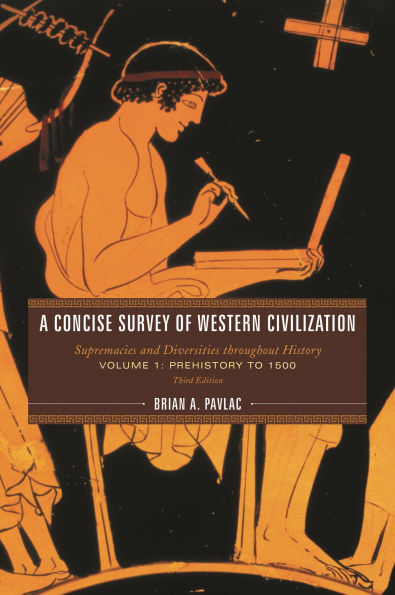This lively text offers a brief, readable description of our common Western heritage as it began in the first human societies and developed in ancient Greece and Rome, then through the Middle Ages. Providing a tightly focused narrative and interpretive structure, Brian A. Pavlac covers the basic historical information that all educated adults should know. His joined terms “supremacies and diversities” develop major themes of conflict and creativity throughout history. “Supremacies” centers on the use of power to dominate societies, ranging from warfare to ideologies. Supremacy seeks stability, order, and incorporation. “Diversities” encompasses the creative impulse that produces new ideas, as well as the efforts of groups of people to define themselves as “different.” Diversity creates change, opportunity, and individuality.
These themes of historical tension and change—whether applied to political, economic, technological, social, or cultural trends—offer a bridging explanatory organization. The text is also informed by five topical themes: technological innovation, migration and conquest, political and economic decision making, church and state, and disputes about the meaning of life. Throughout, judicious “basic principles” present summaries of historical realities and primary source projects offer students the chance to evaluate differing points of view about the past. Written with flair, this easily accessible yet deeply knowledgeable text provides all the essentials for courses on Western Civilization.
This lively text offers a brief, readable description of our common Western heritage as it began in the first human societies and developed in ancient Greece and Rome, then through the Middle Ages. Providing a tightly focused narrative and interpretive structure, Brian A. Pavlac covers the basic historical information that all educated adults should know. His joined terms “supremacies and diversities” develop major themes of conflict and creativity throughout history. “Supremacies” centers on the use of power to dominate societies, ranging from warfare to ideologies. Supremacy seeks stability, order, and incorporation. “Diversities” encompasses the creative impulse that produces new ideas, as well as the efforts of groups of people to define themselves as “different.” Diversity creates change, opportunity, and individuality.
These themes of historical tension and change—whether applied to political, economic, technological, social, or cultural trends—offer a bridging explanatory organization. The text is also informed by five topical themes: technological innovation, migration and conquest, political and economic decision making, church and state, and disputes about the meaning of life. Throughout, judicious “basic principles” present summaries of historical realities and primary source projects offer students the chance to evaluate differing points of view about the past. Written with flair, this easily accessible yet deeply knowledgeable text provides all the essentials for courses on Western Civilization.

A Concise Survey of Western Civilization: Supremacies and Diversities throughout History
336
A Concise Survey of Western Civilization: Supremacies and Diversities throughout History
336Paperback(Third Edition)

Product Details
| ISBN-13: | 9781538112533 |
|---|---|
| Publisher: | Bloomsbury Academic |
| Publication date: | 01/17/2019 |
| Edition description: | Third Edition |
| Pages: | 336 |
| Product dimensions: | 7.00(w) x 9.70(h) x 0.90(d) |
| Age Range: | 18 Years |
